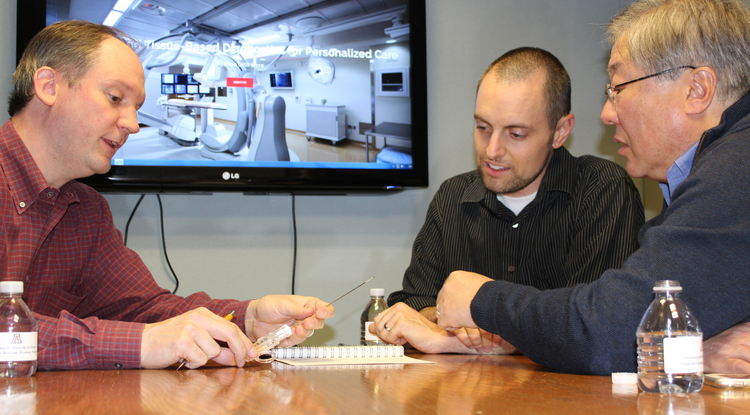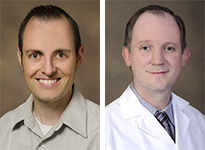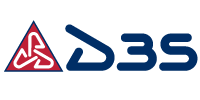The company, D3Sciences, targets accelerated diagnosis and treatment of cancer by providing optimal tissue samples for effective personalized medicine.
 Co-inventors Dr. Charles Hennemeyer (left) and Dr. Michael Larson (center) discuss design ideas with D3S CEO Nick Lim. (Photo: Paul Tumarkin/Tech Launch Arizona)
Co-inventors Dr. Charles Hennemeyer (left) and Dr. Michael Larson (center) discuss design ideas with D3S CEO Nick Lim. (Photo: Paul Tumarkin/Tech Launch Arizona)
The University of Arizona has licensed the design for a next-generation needle biopsy instrument that utilizes electrosurgery and electrocautery to safely increase tissue sample volumes in minimally invasive biopsy procedures.
The licensee is a startup company, Data Driven Diagnostics Sciences Inc., also known as D3Sciences, or D3S. The inventing team includes  Michael Larson, MD, PhD, a resident physician in the UA Department of Medical Imaging and Banner – University Medical Center Tucson, and Charles Hennemeyer, MD, assistant professor of medical imaging and chief of the Division of Interventional Radiology at the UA College of Medicine – Tucson. They worked with Tech Launch Arizona, the office of the UA that commercializes inventions stemming from research, to protect the intellectual property, develop their business strategy and form the executive team.
Michael Larson, MD, PhD, a resident physician in the UA Department of Medical Imaging and Banner – University Medical Center Tucson, and Charles Hennemeyer, MD, assistant professor of medical imaging and chief of the Division of Interventional Radiology at the UA College of Medicine – Tucson. They worked with Tech Launch Arizona, the office of the UA that commercializes inventions stemming from research, to protect the intellectual property, develop their business strategy and form the executive team.
 That D3S leadership team includes chief executive officer Nicholas Lim, who is also a volunteer in TLA’s Commercialization Partners program—which connects experienced business executives and entrepreneurs with UA researchers to advance University inventions into the marketplace.
That D3S leadership team includes chief executive officer Nicholas Lim, who is also a volunteer in TLA’s Commercialization Partners program—which connects experienced business executives and entrepreneurs with UA researchers to advance University inventions into the marketplace.
The inventors set out to solve a fundamental challenge to the rapid and cost-effective delivery of care to cancer patients: insufficient tissue from biopsy procedures. Pathologists receive minuscule amounts of tissue from needle biopsy procedures, insufficient to perform the sophisticated diagnostic tests required for personalized medicine that oncologists prefer to precisely target cancer cells. Without complete pathology results and sufficient tissue for specific therapy tests, oncologists have no choice but to prescribe broad chemo-radiation therapy, which can cause serious side effects.
"The primary advantage of the UA design is its ability to scoop tissue from beyond the confines of the needle, collecting seven times the volume of tissue possible with today's needle biopsy instruments," Hennemeyer explained. "Our device cauterizes in the same procedure, minimizing the risk of complications.
"By providing a tool to obtain larger tissue samples, D3S will enable pathologists to complete comprehensive testing. With expanded test results, oncologists will be able to prescribe targeted genetic and molecular therapies."
Said Lim: "Our overarching goal is to accelerate diagnosis and therapy. Repeat biopsies, which can occur at rates greater than 50 percent of cases, have been shown to increase the cost of care by more than 24 percent. The associated delay in treatment inflicts unnecessary financial and emotional distress to the patient while potentially impacting the odds of successful treatment."
The founding team of D3S met when Hennemeyer and Larson brought their idea to the TLA-run National Science Foundation I-Corps program, where they were paired with Lim as their mentor. NSF I-Corps prepares scientists and engineers to extend their focus beyond the university laboratory and accelerates the economic and societal benefits of NSF-funded, basic-research projects that are ready to move toward commercialization.
"As cancer therapies evolve toward more personalized and now individualized approaches, diagnostic and prognostic testing will develop with increasing speed," said Doug Hockstad, assistant vice president of TLA. "This next-generation biopsy instrument has the promise to deliver the tissue samples needed to perform these leading-edge tests."

